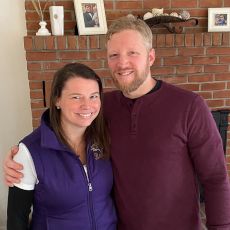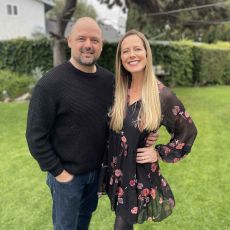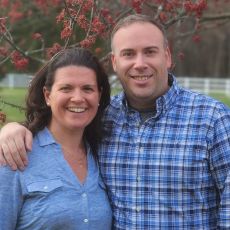Is It Possible to Give an Older Child Up for Adoption?
How the Older Child Adoption Process Works
You may be facing the hardest situation of your life, but there is hope — for yourself, and for your child. Putting an older child up for adoption — whether they are an infant or a toddler — is possible. Call 1-800-ADOPTION now to learn more or to get started.
If you’re considering placing an older child for adoption today, we want you to understand:
-
How the process works
-
How American Adoptions can help
-
What you can do today
While each process is unique, there are some big steps involved in every older child adoption.
Once you understand how it works, you might have a better idea of if placing an older child for adoption is right for you. Or, you could come to see that other avenues of support are better for your situation.
To get more information and find support today, click here or call 1-800-ADOPTION.
Please know that American Adoptions is unable to provide adoption services for children over 4 years old. If you are considering adoption for a child older than 4 years, we have created this guide to your options.
How to Put an Older Child Up for Adoption
Step 1: Decide if Placing an Older Child for Adoption is Right for You
Let’s be honest: parenting is hard. There are emotional, financial and physical challenges.
At what point do those challenges begin to feel so overwhelming that adoption becomes the best option for your family?
The answer is different for every woman. Some signs that adoption may be right for you are:
-
You are financially unable to provide basic needs for yourself and your child.
-
The demands of parenting feel unbearable on your physical and mental health.
-
You believe that a loving adoptive family could provide your child with an amazing life.
Casey, a birth mother who worked with American Adoptions, thought that parenting would work out, even though she knew things wouldn’t be easy. For a while, she seemed to be getting by.
But, between shifts for her overnight job and day job, throwing together a meal and trying to prep notes for a babysitter, she began thinking that there may be something better — for herself and for her children.
“I didn’t have family support… everything was on my own,” she said. “I was just contemplating, ‘What can I possibly do now that would make a difference for our future and provide my sons with the life that I would like to give them?’”
The answer, for Casey and her children, was adoption. That doesn't mean it was an easy choice — putting your child's needs first, not only today but in the future, can be hard.
But, placing an older child for adoption might be the answer for you, too.
No matter what your reasons are, we want you to know that adoption is not “giving up” on your child. Even though “giving up an older child for adoption” is a common phrase, it misses the key point:
You’re doing something brave and loving when you choose adoption.
If placing an older child for adoption is right for you, then you are not “giving up.”
Step 2: Contact American Adoptions [Available 24/7]
If your child is a newborn, a year old or even a toddler, and you are seriously considering older child adoption, then you can call 1-800-ADOPTION today to speak to an adoption specialist.
You can feel confident and safe with our team. We’ve been providing services to prospective birth parents for more than 30 years, including parents who are thinking of putting older children up for adoption.
And we’re always here for you — 24/7.
What can you expect when you call 1-800-ADOPTION?
-
A friendly and compassionate specialist whose goal is to help you create a safe adoption plan
-
Someone who will make you feel safe
-
Important information on how older child adoption works
-
Guidance about whether adoption is right for you, and what your other options may be
-
Clear direction on what to do next
-
And more
We will help you navigate your emotions and understand what is best for your child. You can trust our guidance because we have worked with many other women in similar situations.
Step 3: Social and Medical Histories [What You Will Need]
If you do decide to begin the process of placing an older child for adoption, we’ll get to work as fast as we can. You’ll get an information packet with even more helpful adoption facts, as well as directions for how the older child adoption process will go.
At this point, many prospective birth parents want to know how long the process will take. Ultimately, every process is unique. It’s difficult to say, and much of it is up to you. There are a few steps that may take time, but the more involved and prepared you can be, the quicker the process can move.
One thing you can do right now to move the process along is to start collecting medical and social histories. These are documents that need to be included in the adoption paperwork, like:
-
Prenatal care documents
-
Labor and delivery records
-
Pediatric medical histories
-
The child’s birth certificate
Your adoption specialist will be there every step of the way so that you can feel prepared, confident and at peace with putting an older child up for adoption. They will help you request these documents, but it is ultimately up to you to be proactive about signing the necessary releases for this vital information.
Step 4: Find an Adoptive Family [View Profiles Today]
We know you love your baby, and you want the world for them. That’s why we do everything possible to help you find the best family for your child.
When you put older children up for adoption, you get to choose the adoptive family, just like a woman who places a newborn for adoption.
You can look through adoptive family profiles to find parents who are best prepared to provide your child with a smooth transition into a loving family. Generally, there are more adoptive families who feel prepared to adopt newborns and infants, while there are fewer families ready to adopt a toddler. However, we do work with adoptive families who cannot wait to welcome your 1, 2 or 3-year-old into their loving arms.
To get a sense of the types of people waiting to adopt, you can click here to look at some of our family profiles online.
When you’ve found the family you think will be best for your baby, and all of the necessary medical and social history listed in the step above has been collected, we will reach out to set up the connection.
Helpful Information
Step 5: Your Transition Plan [Doing What’s Best for Your Child]
Did you know that most U.S. infant adoptions are at least semi-open? The same is true when you are putting an older child up for adoption. Open adoption allows you to:
-
Get to know the adoptive parents before placement
-
Develop a transition plan with the family
-
Stay connected with the family after placement
-
Know that your child is safe, loved and happy
The transition plan is one of the most important steps when you are “giving up” an older child for adoption. Essentially, this is the time when your child is placed in the care of the adoptive family.
Depending on how old your child is, this may be difficult and confusing for them to understand. In a transition plan, you will work together with the adoptive parents to help your child feel safe and secure.
Many transition plans take place over the course of several days. It could go something like this:
-
Friday: You may meet together, share a meal and then go home with your child.
-
Saturday: You meet again, but this time leave while your child stays with the adoptive parents. They can play, bond and begin to form a connection.
-
Sunday: It is time for the child to be placed with the adoptive parents. Because of the time you all spent together over the past few days, this placement can feel more natural and safe for your child.
This step of the older child adoption process can be very difficult, and we are here for you. The goal is for you and your child to feel comfortable with this transition. From figuring out the logistics to deciding what to pack and how you can expect to feel, our adoption specialist will be by your side.
Step 6: Complete Your Placement [And Stay Connected Through Open Adoption]
To complete your placement, you’ll need to sign your adoption paperwork. Your specialist and attorney will help you. This is a brave step to take to do what is best for your child.
After the paperwork is signed and the adoption is complete, you can stay connected through open adoption. Every open adoption is different, so it’s up to you to decide what’s best for you and your child.
Open adoption may seem scary at first when you are thinking about putting an older child up for adoption. Wouldn’t a clean break be better? But, many prospective birth mothers, like Caitlin, will tell you about the benefits of open adoption.
“Knowing that I can be around and be there — I don’t even know how to put it into words… I’m like a cheerleader on the sideline, and that’s more than I could have asked for,” Caitlin said.
“He gets this family who can take care of him and do everything I couldn’t, but he can also know that I didn’t just give him away. I had a purpose for him, and it was meant to be.”
Take Your Next Steps Today
Are you ready to speak with a specialist about putting an older child up for adoption? Let’s talk.
You can call 1-800-ADOPTION at any time, 24/7, to speak to an adoption specialist. You can also click here to get more free adoption information online.
More Information about Putting an Older Child Up for Adoption
Now that you know how the older child adoption process works and how you can take your next steps today, we want to make sure there aren’t any questions left unanswered.
Let’s look at some of the most important information about putting older children up for adoption, including the challenges that can come with this decision.
How Putting an Older Child Up for Adoption Is the Same as Other Adoptions
Throughout the toddler adoption process, you will still have the same rights and choices as any mother placing a baby for adoption:
- You can choose the adoptive parents for your child; American Adoptions works with many families who are willing and excited to adopt an older infant or toddler, and occasionally a child up to 4 years old
- You can choose the type of relationship you want to have with your child and the adoptive parents after placement
- You will get the unlimited, 24/7 counseling and support you need to make a fully informed adoption decision that you feel confident with
- You are entitled to free adoption services; your legal and counseling costs will always be covered for you
- You are in control of the adoption process
Whatever circumstances have led you to adoption, placing your toddler with a private agency like American Adoptions allows you to take control of your situation and your child’s future.
Every situation is different, and American Adoptions handles the placement of older children and toddlers on a case-by-case basis. However, if you are considering placing an older child for adoption, and that child is 4 or older, our agency may not be the best resource to help you make an adoption plan for him or her. In those cases, there are many great professionals who would be happy to provide information on how to place an older child up for adoption.
To discuss your individual circumstances and learn how to put a toddler up for adoption, you can reach an adoption professional at any time at 1-800-ADOPTION. We will help you explore all of your options and make the decision that is best for you and your child.
The Challenges of Placing an Older Child for Adoption
If you are considering “giving your older child up” for adoption, you clearly have his or her best interests at heart — and so does American Adoptions. That’s why we think it is important for any parent to have a clear understanding of the potential challenges of placing an older child for adoption.
There are several challenges to consider if you are thinking of putting older children up for adoption:
- While we do work with many families who are open to adopting sibling groups and toddlers, most parents who are interested in adopting an older child work with the state foster system rather than a private agency. This route gives them access to more appropriate services and education about parenting children who are adopted at an older age. This means that we have fewer waiting families who are interested in adopting a school-aged or older child.
- Placing an older child for adoption is often complicated because there are some additional factors to take into consideration, including the child’s health and behavior, others who have had custody of the child throughout his or her life, the involvement of the child’s father, and more. The more you can share about these factors, the better we will be able to provide the services you need.
- "Giving a child up" for adoption is never easy, but it may be an even more challenging adjustment in an older child placement — not only for you as a parent, but also for your child. This process requires specialized counseling, education, and training services. Our agency is prepared to provide these services, such as conducting a safety check, helping you understand your options and providing adoption services, for children up to 4 years old.
Struggling parents should never hesitate to reach out for help.
While American Adoptions may not be able to complete the adoption in every case, we will do whatever we can to refer you to the services and resources you need.
Other Options for Placing an Older Child for Adoption
Unfortunately, many parents in your circumstances find that there is not a lot of readily available information about this type of adoption if their child is more than a few years old. There aren’t many private agencies that specialize in placing older children, and state foster care systems typically do not have the funding to take voluntary relinquishments.
But there are other options if you’re asking, “Where can I put my child up for adoption?”
If you are struggling to parent and thinking about "giving up" a child for adoption and the child is over 4 years old, consider the following suggestions before contacting a private adoption agency:
- Reach out to social services. While the state may not be able to take custody of your child, they can provide resources to make parenting easier. For instance, if your child has significant medical needs that you feel you cannot meet, look into your public healthcare options. If you need help finding a job or affordable housing, the state has programs that may help you. Whatever underlying issues have caused you to consider adoption for your child, there are likely free, public resources in your community to help you address them.
- Consider a temporary guardianship. You may be struggling now, but if you feel that you would be able to parent your child under different circumstances, you may be able to establish a legal guardianship with a close friend or family member. This option gives someone else temporary custody of your child while you make changes that would improve your situation and allow you to parent.
- Complete a kinship adoption. If you are searching for a more permanent solution for your child and have loving family members who are willing to help, you may choose to put your kid up for adoption with a relative. A kinship placement is often beneficial for older children because it allows them to maintain important relationships with loved ones and transition to a familiar home.
- Complete an independent adoption. Through your own networking, you may be able to find a friend or other waiting family who is willing to adopt your child. In these circumstances, you may consider working with an attorney to complete an identified or independent adoption. However, you must be very careful when placing your child with a new family; to ensure his or her safety and wellbeing, you need to contact a licensed child-placing agency in your state to complete a home study for the adoptive family. You should also always work with an attorney to ensure every step of the process is completed safely and legally.
- Take a break. Every parent gets overwhelmed, and sometimes it just takes a day or two of alone time to reset and re-evaluate your situation. If you think this may be the case for you, ask a friend or family member if they would be willing to babysit for a day or weekend, or contact your state social services department and ask about options for respite care.
Although American Adoptions can handle the placement of toddlers and older children up to age 4 on a case‐by‐case basis, our agency specializes in newborn adoption. When “giving your older child up” for adoption, we recommend contacting your local social services department before making an adoption plan.
Contact American Adoptions Today
Choosing adoption for your child can be complicated, both legally and emotionally, but it can also be one of the best decisions you will ever make. If this is what you decide is best in your circumstances, it is important to find the services you need to ensure your child is placed in a safe, supportive and loving environment.
To learn more about how to place an older child up for adoption, or to discuss your other options and resources, you can reach a licensed adoption professional any time, or you can call 1-800-ADOPTION to get free guidance today.
To learn more about how to put a toddler up for adoption or to discuss your other options and resources, you can reach a licensed adoption specialist any time, or contact your state’s social services department for more information on placing an older child for adoption.
Disclaimer
Information available through these links is the sole property of the companies and organizations listed therein. American Adoptions provides this information as a courtesy and is in no way responsible for its content or accuracy.







































